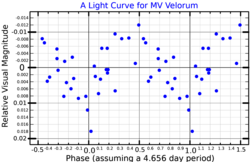HD 89890
| Observation data EpochJ2000EquinoxJ2000 | |
|---|---|
| Constellation | Vela |
| Right ascension | 10h20m54.77319s[2] |
| Declination | −56° 02′ 35.5728″[2] |
| Apparent magnitude(V) | 4.50[3] |
| Characteristics | |
| Spectral type | B3 III + A0 IVpSi + A2 + K0 III[4] |
| B−Vcolor index | −0.102±0.014(A + B)[5] |
| Astrometry | |
| Radial velocity(Rv) | +10.4±2.8[5]km/s |
| Proper motion(μ) | RA:−7.5[6]mas/yr Dec.:+4.0[6]mas/yr |
| Parallax(π) | 2.6564 ± 0.2314mas[2] |
| Distance | 1,200 ± 100ly (380 ± 30pc) |
| Absolute magnitude(MV) | −3.21 (A + B)[5] |
| Details | |
| A (HD 89890) | |
| Radius | 10.07±0.20[7]R☉ |
| Luminosity | 3,082.41[5]L☉ |
| Surface gravity(logg) | 3.00±0.03[7]cgs |
| Temperature | 15,000±150[7]K |
| Rotational velocity(vsini) | 26.8±0.5[7]km/s |
| Other designations | |
| A+B:CPD−55 3286,HIP50676,HR4074[8] | |
| A:J Velorum,MV Velorum,HD89890,SAO237959,TYC8604-975-1[8] | |
| B:SAO237960,TYC8604-2444-1[8] | |
| C:CD−55 3306,SAO237958,TYC8604-2137-1[8] | |
| Database references | |
| SIMBAD | HD 89890 (A) |
| HIC 50676 (A+B) | |
| TYC 8604-2444-1 (B) | |
| CD-55 3306 (C) | |
HD 89890is the brightest member of a multiplestar systemwith at least four components,[4]located in thesouthernconstellationofVela.It is visible to the naked eye with anapparent visual magnitudeof 4.50.[3]The annualparallax shiftof2.6mas[2]provides a distance estimate of around 1,200light-years(370parsecs). It is moving further away from Earth with a heliocentricradial velocityof +10 km/s.[5]
System
[edit]TheWashington Double Star Cataloglists three visible components for this system. The brightest, component A, is of visual magnitude 4.50. Component B has a magnitude of 7.179,[9]and as of 2000 lies at anangular separationof7.10″from A, along a position angle (PA) of 102°. Component C is a magnitude 9.125 star[9]at a separation of36.20″from A at a PA of 191°. The physical link between the stars was described on the basis of their dynamic parallax and mean velocities.[10]The three components A, B and C haveGaia Data Release 2parallaxes of2.6564±0.2314mas,2.1771±0.0490 mas,and1.6097±0.0400 mas,respectively.[2]
Properties
[edit]Component A has astellar classificationof B3 III, and is categorized as aBe star.It showsphotometricvariations with multiple periods around 4.6 days andline-profile variations with a period of 2.318 days. The radial velocity of this star is constant.[4]It has 10[7]times theSun's radiusand shines with 3,082[5]times theSun's luminosityfrom itsphotosphereat aneffective temperatureof15,000K.[7]
The component B shows a variation in spectra consistent with being a double-linedspectroscopic binary.The brighter member (Ba) is asilicon starwith a class of A0 IVpSi, while the fainter component (Bb) is of type A2. Component C has a class of K0 III, indicating it is anevolvedgiant star.The measuredeffective temperatureof C is 5,500 K. The fact that component A most likely shares a common origin with C suggests that the former is much older than expected, and may actually be ablue stragglerformed from the merger of a close binary. This could have been caused by thegravitationalinfluence of an unseen companion of A.[4]
References
[edit]- ^Sterken, C.; Vogt, N.; Mennickent, R. E. (July 1996)."Long-term photometry of Be stars. II. Periodic variations on time scales of days to months".Astronomy and Astrophysics.311:579–586.Bibcode:1996A&A...311..579S.Retrieved30 April2022.
- ^abcdeBrown, A. G. A.;et al. (Gaia collaboration) (August 2018)."GaiaData Release 2: Summary of the contents and survey properties ".Astronomy & Astrophysics.616.A1.arXiv:1804.09365.Bibcode:2018A&A...616A...1G.doi:10.1051/0004-6361/201833051.Gaia DR2 record for this sourceatVizieR.
- ^abJaschek, M; Egret, D; Jaschek, M; Groth, H. -G (1982). "Catalog of Be stars".Be Stars.98:261–263.Bibcode:1982IAUS...98..261J.doi:10.1007/978-94-009-8565-0_44(inactive 2024-06-09).ISBN978-90-277-1367-4.
{{cite journal}}:CS1 maint: DOI inactive as of June 2024 (link) - ^abcdVeramendi, M. E.; González, J. F. (July 2014), "Spectroscopic study of early-type multiple stellar systems. II. New binary subsystems",Astronomy & Astrophysics,567:10,arXiv:1405.1084,Bibcode:2014A&A...567A..35V,doi:10.1051/0004-6361/201423736,S2CID21711755,A35.
- ^abcdefAnderson, E.; Francis, Ch. (2012), "XHIP: An extended hipparcos compilation",Astronomy Letters,38(5): 331,arXiv:1108.4971,Bibcode:2012AstL...38..331A,doi:10.1134/S1063773712050015,S2CID119257644.
- ^abRöser, S.; Bastian, U. (September 1988), "A New Star Catalogue of SAO Type",Astronomy and Astrophysics Supplement Series,74:449,Bibcode:1988A&AS...74..449R.
- ^abcdefArcos, C.; et al. (March 2018), "Stellar parameters and H α line profile variability of Be stars in the BeSOS survey",Monthly Notices of the Royal Astronomical Society,474(4): 5287–5299,arXiv:1711.08675,Bibcode:2018MNRAS.474.5287A,doi:10.1093/mnras/stx3075,S2CID74872624.
- ^abcde"HD 89890".SIMBAD.Centre de données astronomiques de Strasbourg.Retrieved2018-08-08.
- ^abHøg, E.; et al. (March 2000). "The Tycho-2 catalogue of the 2.5 million brightest stars".Astronomy and Astrophysics.355:L27–L30.Bibcode:2000A&A...355L..27H.doi:10.1888/0333750888/2862.ISBN978-0333750889.
- ^Mason, B. D.; et al. (2014), "The Washington Visual Double Star Catalog",The Astronomical Journal,122(6): 3466–3471,Bibcode:2001AJ....122.3466M,doi:10.1086/323920.

